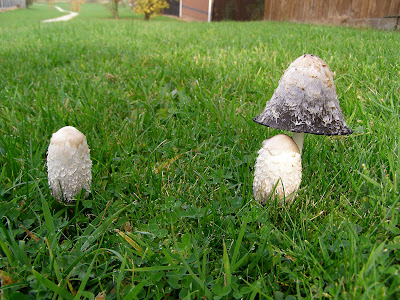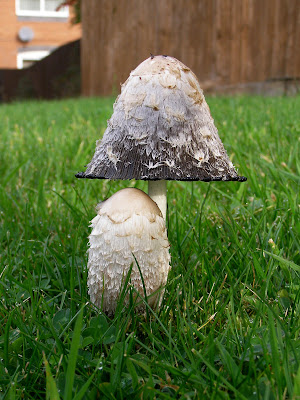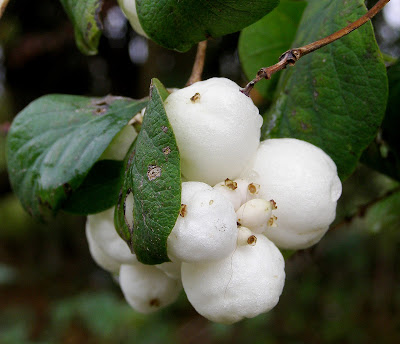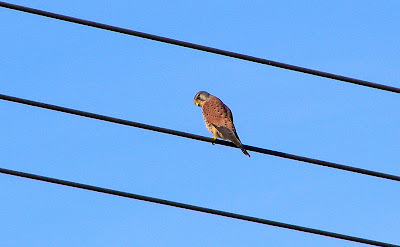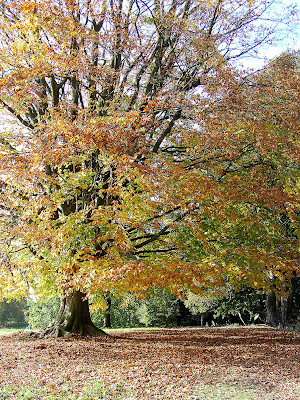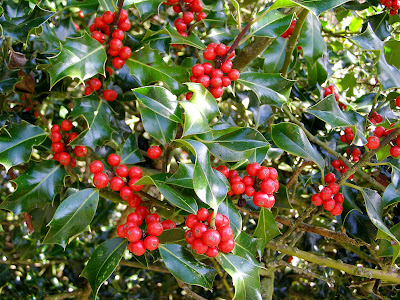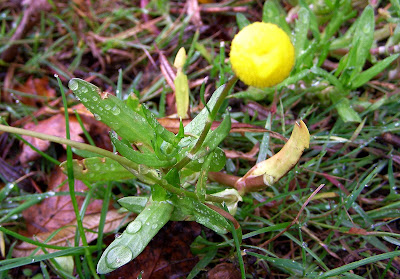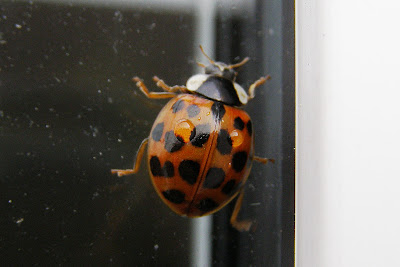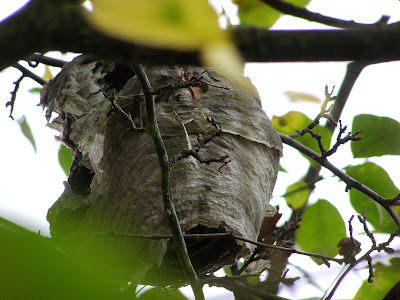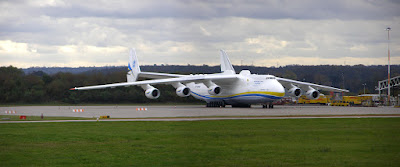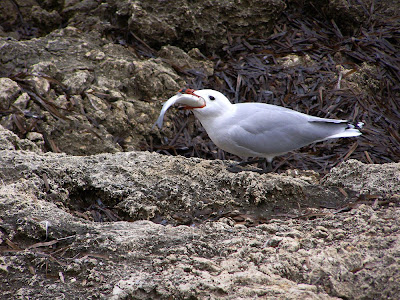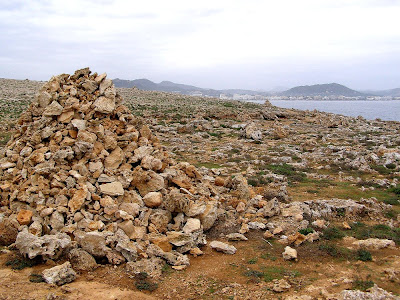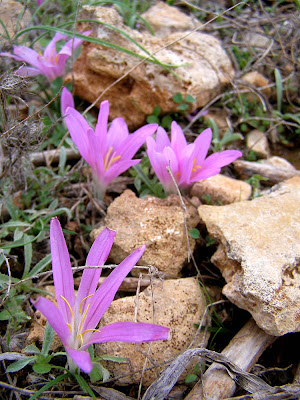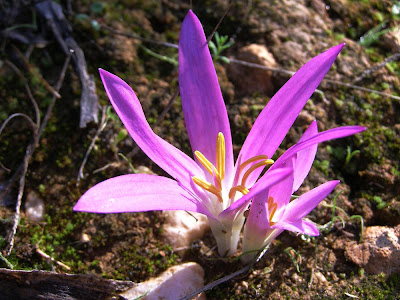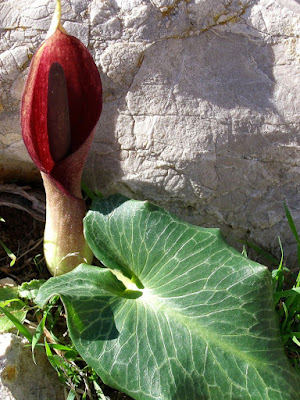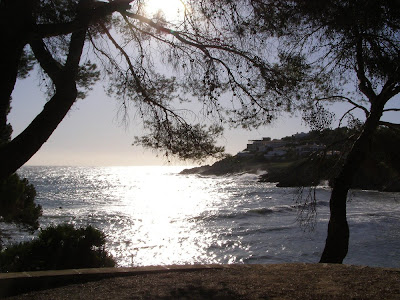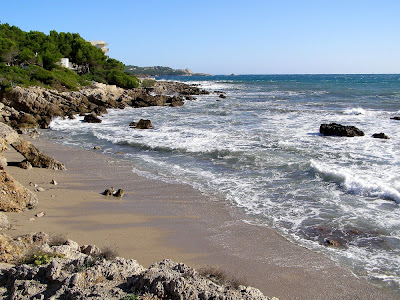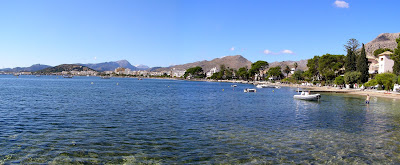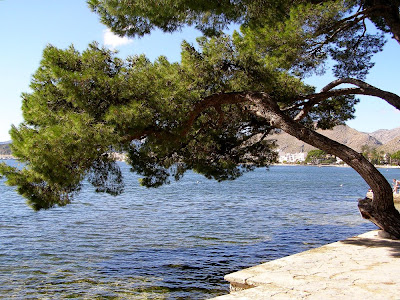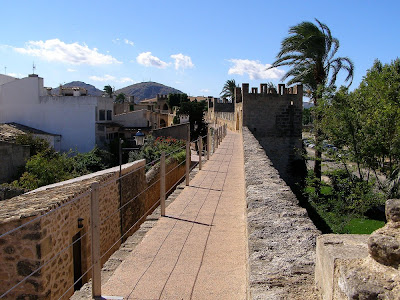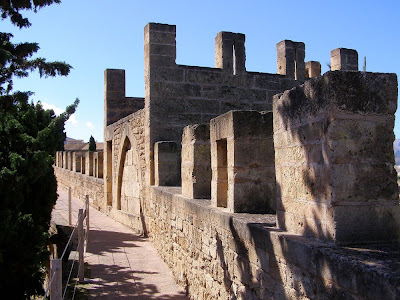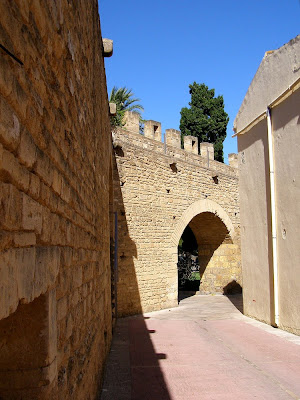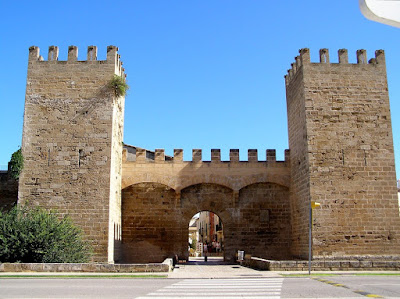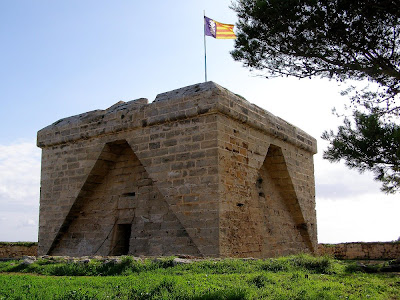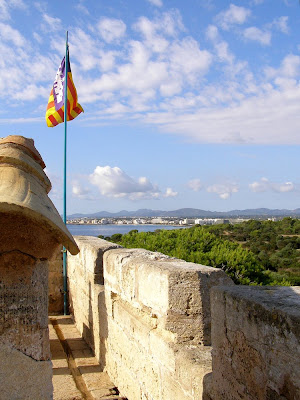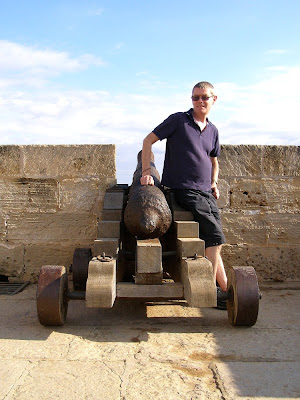With temperatures reaching levels more suited to late August, it certainly hasn't felt much like Autumn just lately. The sight of bare branches, misty mornings and heavy dew on the grass in the mornings however, point us to the undeniable truth that Christmas isn't far off (sorry to mention the 'C' word).
The damp mornings have been very good news for the fungi, thrusting up from the grass. This Shaggy Inkcap (Coprinus comatus) for instance.
First getting it's common name in 1797, the Shaggy Inkcap is a strange thing inasmuch as the cap of the fungus, when it has opened, starts to disintegrate around the edges, forming a thick, black 'ink' which drips off around the fungus.
You can see this process starting in the larger specimen in this picture, while the smaller one has yet to open and begin the process.
Other Autumnal 'fruits' in abundance at the moment are those belonging to the Snowberry (Symphoricarpos albus).
A relative of the Honeysuckle, the fruits are valuable to various bird species including Grouse, Partridge and Pheasant. If eaten by humans the berries can cause vomiting, dizziness, and slight sedation in children - the latter of which sounds like a good idea to me!
While out walking yesterday, we encountered this delightful bird searching for a meal - a Kestrel (Falco tinnunculus), a male bird in this case.
A familiar member of the family of falcons, they are found almost everywhere in Britain and are a common sight as they hover by the side of motorways, looking for small mammal prey. This task is made easier for the Kestrel as it is able to see into the near ultraviolet light and in such light the urine trails of the mice, voles, etc. which it is hunting, begin to 'shine'. Extraordinary!
Welcome to my blog. Don't expect anything too high-tech or flashy, this is simply a 'diary' to share some of my photos, thoughts and observations - with a particular bias towards the natural world and the countryside around my home.
Saturday 31 October 2009
Friday 30 October 2009
Signs
With Autumn drawing to it's close and the prospect of winter's low temperatures are gaining on us, it's nice to see that the wonderful colours of this season are still visible. This fine old Beech (Fagus sylvatica) tree on Shipley Hill, is resplendent in it's Autumn dress.
This tree must be well over 100 years old as it stands so tall and stately on the edge of the hill overlooking the Erewash Valley. If trees could talk, this one would have plenty of stories to tell of sights it had seen.
The mention of Winter, brings Christmas to mind. A thought which is exacerbated by the sight of a large Holly (Ilex aquifolium)tree in full fruit.
The berries, very popular as Christmas decorations in our homes, are a major source of food for many of our bird species after the first frosts of winter have softened them and made them more palatable. They are mildly toxic to humans and likely to cause vomiting and diarrhea if eaten.
This tree must be well over 100 years old as it stands so tall and stately on the edge of the hill overlooking the Erewash Valley. If trees could talk, this one would have plenty of stories to tell of sights it had seen.
The mention of Winter, brings Christmas to mind. A thought which is exacerbated by the sight of a large Holly (Ilex aquifolium)tree in full fruit.
The berries, very popular as Christmas decorations in our homes, are a major source of food for many of our bird species after the first frosts of winter have softened them and made them more palatable. They are mildly toxic to humans and likely to cause vomiting and diarrhea if eaten.
Wednesday 28 October 2009
Invaders
There are many species of plants and animals at large in the UK which are non-native. Yesterday, we discovered one growing around the lake at Straw's Bridge. A small, bright-yellow flowered plant, growing in the wet soils by the lake. It took some looking up trying to identify it, but eventually I discovered it is a Buttonweed (Cotula coronopifolia).
A native of south Africa, this plant has spread to many parts of the world and has recently started to colonise the UK, helped in great part, by the birds which spread the seeds. Also called Brass Buttons, the plant is very tolerant of salt conditions and stores water in it's fleshy stems and leaves in order to stave off the worst effects of drought or saline inundation.
Nice to see such a bright flower in bloom at this time of year.
Next, an invader which has been getting much publicity of late. The Harlequin Ladybird (Harmonia axyridis). In this case the variety 'succinea'.
In the warm weather of the past few days, they have been seen flying all over the garden and scurrying up the windows. The most invasive ladybird on the planet, originating in eastern Asia, it was introduced to North America in 1988, where it is now the most widespread ladybird species on the continent. It has already invaded much of northwestern Europe, and arrived in Britain in summer 2004.
Harlequin ladybirds feed mostly on aphids, but also on scale insects, adelgids, the eggs and larvae of butterflies and moths, many other small insects, including other ladybirds, pollen, nectar, and sugary fluids, including honeydew and the juice from ripe fruits. A single female can lay over a thousand eggs!
A native of south Africa, this plant has spread to many parts of the world and has recently started to colonise the UK, helped in great part, by the birds which spread the seeds. Also called Brass Buttons, the plant is very tolerant of salt conditions and stores water in it's fleshy stems and leaves in order to stave off the worst effects of drought or saline inundation.
Nice to see such a bright flower in bloom at this time of year.
Next, an invader which has been getting much publicity of late. The Harlequin Ladybird (Harmonia axyridis). In this case the variety 'succinea'.
In the warm weather of the past few days, they have been seen flying all over the garden and scurrying up the windows. The most invasive ladybird on the planet, originating in eastern Asia, it was introduced to North America in 1988, where it is now the most widespread ladybird species on the continent. It has already invaded much of northwestern Europe, and arrived in Britain in summer 2004.
Harlequin ladybirds feed mostly on aphids, but also on scale insects, adelgids, the eggs and larvae of butterflies and moths, many other small insects, including other ladybirds, pollen, nectar, and sugary fluids, including honeydew and the juice from ripe fruits. A single female can lay over a thousand eggs!
Tuesday 27 October 2009
Wasp!
Moving on from the biggest flying thing in the world, to something far smaller, but far more frightening (apologies to Malcolm, who hates the things). WASPS!
On our walk this morning, we encountered a small wasp's nest in a tree, visible now that the leaves have fallen.
Malcolm kept walking...as I took a few pictures of this wonderfully intricate piece of house-building. If you look closely at the hole in the bottom of the - now abandoned - nest you can just make out some of the internal 'walls' of the nest. Entirely made of paper from chewed wood and saliva from the wasp, they are quite wonderful structures, even if Malcolm became a little 'twitchy' at the thought that we had walked past this nest, full of wasps, several times a week during the Summer!
A different type of wasp next, not a traditional 'stinging' type of wasp, this time an Ichneumon Wasp (Stenichneumon militarius).
This one was snapped a few days ago on the path in Shipley Park. This, large Ichneumon wasp was quite large, with a body about 1" long. No threat to humans, it would be a different matter if you were a caterpillar. Adult females, lay their eggs under the skin of a caterpillar, where the wasp larvae hatch out and begin to devour the unfortunate caterpillar from the inside - Charming!
Having eaten it's host, the larva pupates, eventually emerging as another adult Ichneumon and starting the whole cycle all over again.
On our walk this morning, we encountered a small wasp's nest in a tree, visible now that the leaves have fallen.
Malcolm kept walking...as I took a few pictures of this wonderfully intricate piece of house-building. If you look closely at the hole in the bottom of the - now abandoned - nest you can just make out some of the internal 'walls' of the nest. Entirely made of paper from chewed wood and saliva from the wasp, they are quite wonderful structures, even if Malcolm became a little 'twitchy' at the thought that we had walked past this nest, full of wasps, several times a week during the Summer!
A different type of wasp next, not a traditional 'stinging' type of wasp, this time an Ichneumon Wasp (Stenichneumon militarius).
This one was snapped a few days ago on the path in Shipley Park. This, large Ichneumon wasp was quite large, with a body about 1" long. No threat to humans, it would be a different matter if you were a caterpillar. Adult females, lay their eggs under the skin of a caterpillar, where the wasp larvae hatch out and begin to devour the unfortunate caterpillar from the inside - Charming!
Having eaten it's host, the larva pupates, eventually emerging as another adult Ichneumon and starting the whole cycle all over again.
By the way, today is the first anniversary of this blog! Happy first birthday Random Jottings...
Monday 26 October 2009
Biggest!
Quite an exciting day toda. Following reports of an Antonov AN225 on the tarmac at East Midlands Airport, we decided to take a drive out to see it. For those not in the know, the AN225 is the largest fixed-wing aircraft ever built.
We had heard that the plane was due to leave at 11 o'clock this morning, so we set out in good time to catch it taking off. It promised to be a very exciting spectacle (for those of us who like aircraft).When we arrived, there were already many people standing with their faces pressed up against the chain-link fence of the airport perimeter. Some of the gathering throng had air-band radios listening for any indication from the control tower that the plane was ready to go. But none came. So we had to be content with distant views of the static aircraft, standing on the tarmac adjacent to the huge DHL cargo centre at East Midlands.
The AN225 is absolutely enormous. It has a wingspan of just over 290ft. It is 275.6ft long. It weighs over 280 tons empty and has a maximum take-off weight of more that 590 tons. It can carry a payload of 46,000 cubic feet.
With a full load, the plane takes a little under 2 miles to get off the ground. What a fantastic thing.
Pity we didn't get to see it take off. But, here is a video of it anyway...
Sunday 25 October 2009
Wild Life
To end the run of pictures from our Mallorcan holiday, some photos of the wildlife to be seen around the island.
The first ones are of a Mediterranean Gull (Ichthyaetus melanocephalus) which was doing it's best to swallow a fish on the shore of Cala Bona. The fish seemed to be far too big for the bird to get down, but it persevered....Going....
Going......
By this time, quite a crowd had gathered to witness this feat of gluttony, not that the gull was interested in it's audience. Eventually the fish disappeared - all except for the tail, which still protruded from the gull's beak while the bird looked a little wide-eyed, 'full' and in need of a Rennie!
..... Gone....
An altogether more elegant bird was seen strolling along the beach at Port de Pollenca, a Little Egret (Egretta garzetta).
Quite used to the presence of hundreds of people on the beach and promenade, it casually strolled along the waterline, searching for a fishy meal.
Smaller now and a little bird singing his heart out on the dried stem of a shrub near the Castell de N'Amer. A Stonechat (Saxicola rubicola), so called because it's call sounds like someone hitting two small stones together.
Arguably the 'wildest' of them all was the sight of Malcolm, bravely trying to finish his Brandy on the seafront at Cala Bona.
He was obviously having a hard time of it but, like the gull with it's fish, he persevered! Not a bad end to the holiday.
The first ones are of a Mediterranean Gull (Ichthyaetus melanocephalus) which was doing it's best to swallow a fish on the shore of Cala Bona. The fish seemed to be far too big for the bird to get down, but it persevered....Going....
Going......
By this time, quite a crowd had gathered to witness this feat of gluttony, not that the gull was interested in it's audience. Eventually the fish disappeared - all except for the tail, which still protruded from the gull's beak while the bird looked a little wide-eyed, 'full' and in need of a Rennie!
..... Gone....
An altogether more elegant bird was seen strolling along the beach at Port de Pollenca, a Little Egret (Egretta garzetta).
Quite used to the presence of hundreds of people on the beach and promenade, it casually strolled along the waterline, searching for a fishy meal.
Smaller now and a little bird singing his heart out on the dried stem of a shrub near the Castell de N'Amer. A Stonechat (Saxicola rubicola), so called because it's call sounds like someone hitting two small stones together.
Arguably the 'wildest' of them all was the sight of Malcolm, bravely trying to finish his Brandy on the seafront at Cala Bona.
He was obviously having a hard time of it but, like the gull with it's fish, he persevered! Not a bad end to the holiday.
Saturday 24 October 2009
Last Day!
The last full day of our holiday was another 'day off' from driving around. We opted once again, for the lovely walk to the Castell de N'Amer and the headland on which it sits. The wind had picked up a bit in the few days since our last walk there and the sea was 'animated' to say the least. The rocky headland - composed of that ancient coral reef - is strewn with strange cairns of loose rocks piled high by previous visitors. We added our stones to the piles, well it was impossible not to.
Breakers rolled in from the sea and crashed onto the rocks, sending spray high into the air and onto our specs.
The area is a nature reserve and with good reason. The flora is quite beautiful, even at this time of year. Among the most numerous flowers to be seen are the Autumn Crocus (Colchicum autumnale) which are poking up through the rocky soil.
These vibrant little flowers are particularly visible as they only send out their blooms after the leaves have withered and died in the heat of the summer. The inner part of the flower contains several bright, yellow stamens, famous as the extraordinarily expensive spice Saffron.
Another small, delicate flower which is in evidence at this time of year is this little, white Narcissus (Narcissus serotinus).
Standing on a stalk no more than 6" high, these tissue-like blooms nod in the breeze dancing like little ballerinas.
On the subject of flora, while we were at the Mirador d'es Colomer, we spotted a rather gorgeous Arum Lilly growing, seemingly out of the bare rock.
Arum pictum is a tuberous perennial with green, arrow-shaped leaves with creamy-white veins appearing over winter. It is the only Arum to flower in autumn, bearing a purple-black spathe. Red berries appear in the summer months.
Breakers rolled in from the sea and crashed onto the rocks, sending spray high into the air and onto our specs.
The area is a nature reserve and with good reason. The flora is quite beautiful, even at this time of year. Among the most numerous flowers to be seen are the Autumn Crocus (Colchicum autumnale) which are poking up through the rocky soil.
These vibrant little flowers are particularly visible as they only send out their blooms after the leaves have withered and died in the heat of the summer. The inner part of the flower contains several bright, yellow stamens, famous as the extraordinarily expensive spice Saffron.
Another small, delicate flower which is in evidence at this time of year is this little, white Narcissus (Narcissus serotinus).
Standing on a stalk no more than 6" high, these tissue-like blooms nod in the breeze dancing like little ballerinas.
On the subject of flora, while we were at the Mirador d'es Colomer, we spotted a rather gorgeous Arum Lilly growing, seemingly out of the bare rock.
Arum pictum is a tuberous perennial with green, arrow-shaped leaves with creamy-white veins appearing over winter. It is the only Arum to flower in autumn, bearing a purple-black spathe. Red berries appear in the summer months.
Friday 23 October 2009
Re-Visit
Tuesday of our holiday and we decided to have a look round a part of the island which Malcolm had stayed in some years ago. We started at yet another small fishing village (there are so many!), this time called Cala Ratjada.
No longer a small village, it is now a major draw for holidaymakers, especially the Germans, who seem to have taken over the place. As the sun shone through the shady pines, we took a long walk from where we parked the car at Font de Sa Cala into the town.
An onshore breeze kept it comfortable until we stopped for a coffee in Cala Ratjada. Sitting in the sun and out of the breeze, it was scorching, but the view was well worth it.
Moving on, we had a look at the small, inland town of Capdepera, just a couple of miles from Cala Ratjada.
This medieval town lies in the shadow a 14th century castle and you get some magnificent views of the surrounding countryside from the top of the hill - but the climb up there was quite a strain.
The town features large in the mythology of the island, especially in connection to King Jaume I's reconquest of Mallorca from the Moors.
An annual fiesta is held in the town on 18th December celebrating the defeat of the Moors and the 'miracle of the Fog'. This was when a dense fog is supposed to have descended over the hill following the placement, by the townspeople, of a statue of Our Lady of Hope, on the castle battlements. This so terrified the Moors that they fled in fear. Looking back to the castle on hill from a bit further away, you get a better idea of the scale, as well as a view of the lighthouse built in the middle of the castle.
No longer a small village, it is now a major draw for holidaymakers, especially the Germans, who seem to have taken over the place. As the sun shone through the shady pines, we took a long walk from where we parked the car at Font de Sa Cala into the town.
An onshore breeze kept it comfortable until we stopped for a coffee in Cala Ratjada. Sitting in the sun and out of the breeze, it was scorching, but the view was well worth it.
Moving on, we had a look at the small, inland town of Capdepera, just a couple of miles from Cala Ratjada.
This medieval town lies in the shadow a 14th century castle and you get some magnificent views of the surrounding countryside from the top of the hill - but the climb up there was quite a strain.
The town features large in the mythology of the island, especially in connection to King Jaume I's reconquest of Mallorca from the Moors.
An annual fiesta is held in the town on 18th December celebrating the defeat of the Moors and the 'miracle of the Fog'. This was when a dense fog is supposed to have descended over the hill following the placement, by the townspeople, of a statue of Our Lady of Hope, on the castle battlements. This so terrified the Moors that they fled in fear. Looking back to the castle on hill from a bit further away, you get a better idea of the scale, as well as a view of the lighthouse built in the middle of the castle.
Thursday 22 October 2009
North Coast
Down from the high points of the Cap de Formentor, we visited another small fishing village which has become a popular tourist destination, Puerto Pollenca. Despite it's poularity, it remains, somehow, unspoilt and is considered to be one of the best bays in the whole of the Mediterranean.
The sea was so calm on the day we were there you could have been forgiven for thinking it was a lake - particularly as it is difficult to see the opening to the bay and the sea beyond, which gives the whole scene an 'isolated' air.
The lively promenade with the usual mixture of cafes, restaurants, villas and hotels, is dotted with wonderful old pine trees, some of them overhanging the sea, scattering their needles into it.
A little further along the coast and we arrived at the ancient, walled town of Alcudia. The town started life as a Phoenician settlement and was later held by the Greeks before becoming the capitol of the 'Balearis Major' under the Romans in 123BC.
When the Moors took control of the area, they renamed the town al-Kudia, meaning 'on the hill'. Like many Spanish towns, it was sited a little way inland to save it from sea-bound attack.
The small streets within the walls can become (like most places on the island) very busy. Fortunately it was quiet when we were there.
There are two main gates remaining, leading into the old town. Built in the 1400's they are a formidable reminder of times gone by. This gate is known as the Sant Sebastian gate.
A walk along the walls affords some lovely views of the old town and the surrounding countryside.
The sea was so calm on the day we were there you could have been forgiven for thinking it was a lake - particularly as it is difficult to see the opening to the bay and the sea beyond, which gives the whole scene an 'isolated' air.
The lively promenade with the usual mixture of cafes, restaurants, villas and hotels, is dotted with wonderful old pine trees, some of them overhanging the sea, scattering their needles into it.
A little further along the coast and we arrived at the ancient, walled town of Alcudia. The town started life as a Phoenician settlement and was later held by the Greeks before becoming the capitol of the 'Balearis Major' under the Romans in 123BC.
When the Moors took control of the area, they renamed the town al-Kudia, meaning 'on the hill'. Like many Spanish towns, it was sited a little way inland to save it from sea-bound attack.
The small streets within the walls can become (like most places on the island) very busy. Fortunately it was quiet when we were there.
There are two main gates remaining, leading into the old town. Built in the 1400's they are a formidable reminder of times gone by. This gate is known as the Sant Sebastian gate.
A walk along the walls affords some lovely views of the old town and the surrounding countryside.
Wednesday 21 October 2009
Viewpoint
Monday saw us back on the road again and exploring the north-western tip of the island and the spectacular peninsular of Formentor. Arriving at the car park, we struggled to find a place to park as it was so busy. We soon found out why.
At it's highest point the cape rises to more than 1,200ft and affords the most spectacular views imaginable. From the viewpoint we are a 'mere' 600ft or so above the surging sea below.
The locals call this cape the 'meeting point of the winds' but on a clear, warm and still day such as it was when we were there, what breeze there was, was most welcome.
Vertical walls of rock - again formed from ancient coral reefs - rise from the sea providing perfect nesting and hunting sites for a host of exotic birds such as the huge Black Vulture. We were not lucky enough to see one of these giants of the sky, but with views such as these, you can't have everything.
It required a strong stomach to lean over the parapet and look straight down from the viewpoint. Best to just hold out the camera, point it down and click!!!!
Simply breathtaking.
At it's highest point the cape rises to more than 1,200ft and affords the most spectacular views imaginable. From the viewpoint we are a 'mere' 600ft or so above the surging sea below.
The locals call this cape the 'meeting point of the winds' but on a clear, warm and still day such as it was when we were there, what breeze there was, was most welcome.
Vertical walls of rock - again formed from ancient coral reefs - rise from the sea providing perfect nesting and hunting sites for a host of exotic birds such as the huge Black Vulture. We were not lucky enough to see one of these giants of the sky, but with views such as these, you can't have everything.
It required a strong stomach to lean over the parapet and look straight down from the viewpoint. Best to just hold out the camera, point it down and click!!!!
Simply breathtaking.
Tuesday 20 October 2009
Castell
On Sunday 11th, we decided to have a 'day off' from our driving around and stayed closer to home.
Taking the promenade southward through the next resort of Cala Millor, we found ourselves leaving behind the hustle and bustle - and all the Germans! and walking out onto the small headland called the Punta de N'Amer. On the top of this promontory there sits a small, fortified tower, the Castell de N'Amer.
This watch tower was built in 1698. Proposals to build such a fortified 'castillo' were already drawn up one hundred years earlier, but it took a long time and an intervening attack by pirates from the Turkish shores to agree on its execution as well as the small matter of funding.
The tiny fortress is unique in Mallorca for its square shape, its moat and its drawbridge. At the time of it's construction, two canons and four guards were sufficient to guard the shoreline. No more Saracen attacks were reported after its construction. With a fearsome guard as this one...... who can blame them?
The tower stands within the 500 acre natural park of the 'punta' which includes long stretches of coastal dunes (a fast disappearing habitat), pine woods and scrub land. The tower gives you a wonderful view along the whole coastline. Time for one last look and then its almost a 4 mile walk back to our hotel which is in the far distance in this shot, almost at the right hand edge of the built-up area.
Taking the promenade southward through the next resort of Cala Millor, we found ourselves leaving behind the hustle and bustle - and all the Germans! and walking out onto the small headland called the Punta de N'Amer. On the top of this promontory there sits a small, fortified tower, the Castell de N'Amer.
This watch tower was built in 1698. Proposals to build such a fortified 'castillo' were already drawn up one hundred years earlier, but it took a long time and an intervening attack by pirates from the Turkish shores to agree on its execution as well as the small matter of funding.
The tiny fortress is unique in Mallorca for its square shape, its moat and its drawbridge. At the time of it's construction, two canons and four guards were sufficient to guard the shoreline. No more Saracen attacks were reported after its construction. With a fearsome guard as this one...... who can blame them?
The tower stands within the 500 acre natural park of the 'punta' which includes long stretches of coastal dunes (a fast disappearing habitat), pine woods and scrub land. The tower gives you a wonderful view along the whole coastline. Time for one last look and then its almost a 4 mile walk back to our hotel which is in the far distance in this shot, almost at the right hand edge of the built-up area.
Subscribe to:
Posts (Atom)
